Benefits of Omega 3 fatty acid
Do you have enough omega 3 fatty acids in your diet?
The evolutionary human diet had 1:1 omega 6 fatty acids to omega 3 fatty acids ratio. Today most modern diets have a 10:1 to 30:1 omega 6 fatty acids to omega 3 fatty acids ratio. So what? Both fatty acids are essential to our diet and help regulate your body’s metabolic and inflammatory state. Omega 6 fatty acids are much more inflammatory than omega 3 fatty acids and if the ratio is altered, the body’s homeostatic state is altered.
Our ancestors ate real food like game meat, seafood, fruits, vegetables, nuts, and seeds. They ate a variety of seasonal foods and had healthy habits around food. Today we eat more processed foods, such as, grains, sugars, and unhealthy fats/oils. Even the animals we raise are no longer fed their evolutionary diet. Cows are meant to graze on grass but are fed grains, which increase their omega 6 fatty acids. We also eat too much. We snack all day and use food as a coping mechanism for psychological stress.
How you can get enough omega 3 fatty acids in your diet?
There are marine sources of omega 3 fatty acids eicosapentaenoic acid (EPA), and docosahexaenoic acid (DHA). α-linolenic acid (ALA) is found in plant oils, most commonly flax oil. While ALA is great the more benefical source is EPA/DHA.
The best source of omega 3 fatty acids (EPA/DHA) is oily fish like anchovies, sardines, herring mackerel, and wild caught salmon. We need about 2-3 servings a week. Avoiding processed foods in our diet will decrease our omega 6 fatty acids. If you do not eat this much fish you should consider a quality fish oil supplement.
Effects of fish oil on your health and longevity
Acute stress and inflammation is an important function of the immune system and the healing process. However, chronic inflammation caused by poor diet, physical inactivity, psychological stress, and genetic function contributes to heart disease, diabetes, stroke, Rheumatoid Arthritis, Alzheimer’s disease and more. Omega 3 fatty acids have a role in combating these chronic diseases.
Omega 3 fatty acids are responsible for proper functioning of the cell membranes of all the cells in your body. The health of your cells determines the health of your brain and body. Thus, omega 3 fatty acids play a role in all functions of your body including growth and development, brain and nerve function, digestion, immune function, hormone regulation, skin and bone health, regulation of inflammation and healing, blood triglyceride levels, cardiovascular function, vision, and emotions and behavior.
Canadians do not consume enough omega 3 fatty acids in their diet and supplementing may help prevent and treat disease. It can be a simple step toward living your life!



